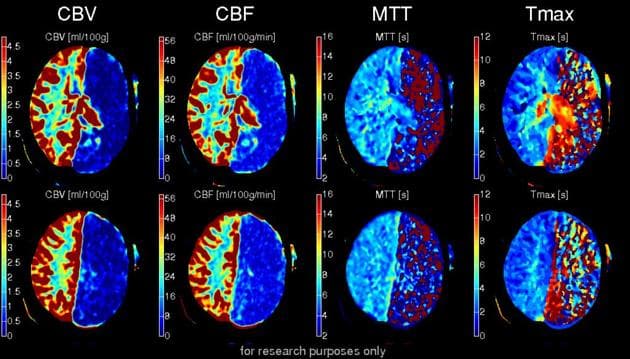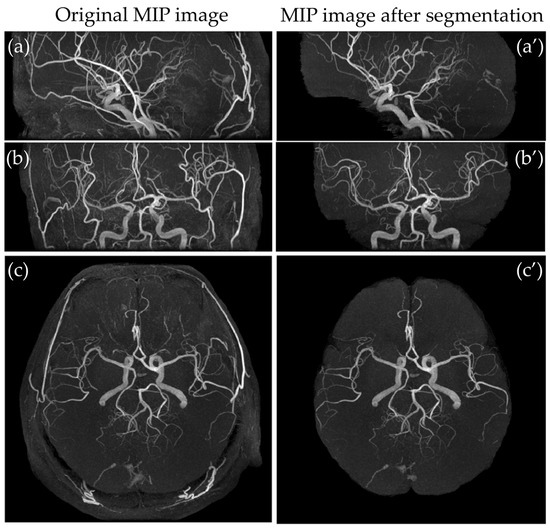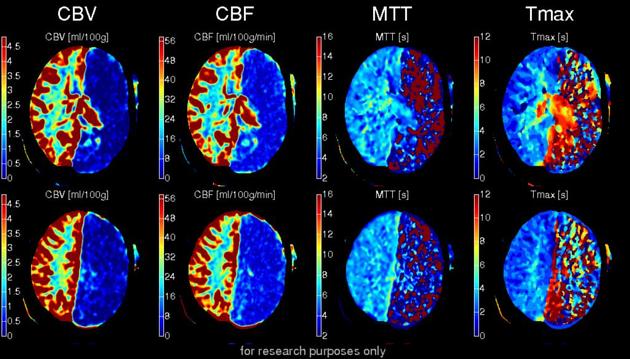AI-Powered CT Perfusion Analysis for Acute Stroke Assessment
Deep learning-enhanced pipeline for automated stroke analysis combining classical perfusion imaging with modern AI - Real-time tissue classification to guide life-saving treatment decisions

Abstract
Time is brain. In acute ischemic stroke, every minute without treatment means the loss of 1.9 million neurons. CT Perfusion (CTP) imaging provides the critical information clinicians need to make life-saving treatment decisions: which brain tissue can still be saved, and which is already lost. This project presents an advanced AI-powered pipeline that automates CTP analysis, combining classical signal processing with deep learning to deliver accurate tissue classification in under 90 seconds—fast enough to guide emergency thrombectomy decisions.
The Clinical Challenge
Acute ischemic stroke occurs when a blood clot blocks an artery supplying the brain. Modern treatments like mechanical thrombectomy can remove these clots and restore blood flow, but success depends on answering a crucial question: Is there still salvageable brain tissue?
CT Perfusion imaging tracks how contrast dye flows through the brain over 60-90 seconds, revealing two critical tissue types:
- Ischemic Core: Tissue with severely reduced blood flow (< 30% of normal) that's likely irreversibly damaged—shown in red on clinical maps
- Penumbra: Tissue with compromised perfusion but maintained viability—the therapeutic target for intervention, shown in green
The challenge lies in automated, accurate, and rapid quantification of these tissue compartments from dynamic CT acquisitions, handling patient motion, noisy data, and protocol variations across hospitals.
Pipeline Architecture: Seven Stages to Tissue Classification
The system processes CTP scans through a sophisticated multi-stage pipeline designed for clinical reliability:
1. Intelligent DICOM Processing
Medical images arrive in DICOM format with complex metadata. The pipeline automatically reconstructs the 4D volume (x, y, z, time) from potentially out-of-order slices, handling variations across different scanner manufacturers and acquisition protocols.
2. Brain Tissue Segmentation
Before analyzing perfusion, we need to know where the brain is. A combination of density thresholding, connected component analysis, and morphological operations creates a "brain mask" that excludes skull, cerebrospinal fluid, and non-brain structures—focusing all subsequent analysis on relevant tissue.
3. Motion Correction with Deep Learning
Patients don't stay perfectly still during the 60-90 second scan. Even small movements (2-3mm shifts) can corrupt perfusion measurements. Traditional registration methods are too slow for clinical use.
Solution: A custom deep neural network predicts motion parameters directly from image pairs, processing the entire 4D volume in 15-25 seconds. The network uses an encoder-decoder architecture with keypoint representations to estimate rotation and translation for each time point, then warps images back into alignment.
Impact: Robust perfusion calculations even with significant patient motion.
4. Arterial and Venous Input Function Detection
Perfusion quantification requires knowing how contrast enters the brain (Arterial Input Function - AIF) and exits through veins (Venous Output Function - VOF). Selecting the wrong blood vessels leads to systematic errors in all tissue measurements.
Multi-Strategy AIF Selection:
We implement a hierarchical approach with multiple fallback strategies:
- Signal-Based Selection: Analyze contrast enhancement curves across all brain voxels, ranking candidates by peak signal quality
- MCA Segmentation-Guided Selection: A U-Net model segments the Middle Cerebral Artery territory from maximum intensity projections, restricting AIF selection to anatomically appropriate regions
- Physiological Validation: Generate preliminary perfusion maps and verify they meet plausibility criteria (penumbra shouldn't exceed 40% of brain volume)
The final AIF averages the top 3-5 candidates, providing robustness against single-voxel noise.
Sinus Segmentation for VOF:
A custom U-Net with ResNet50 backbone segments venous sinuses (superior sagittal sinus, transverse sinuses) from maximum intensity projections. This anatomical constraint dramatically reduces VOF selection failures—a common problem in commercial systems where VOF is incorrectly placed in arteries or brain tissue.
 Deep learning-based segmentation of cerebral vasculature from CT perfusion data. The model identifies arterial structures (MCA territory) for AIF selection and venous sinuses for VOF selection, providing anatomical constraints that improve perfusion quantification accuracy
Deep learning-based segmentation of cerebral vasculature from CT perfusion data. The model identifies arterial structures (MCA territory) for AIF selection and venous sinuses for VOF selection, providing anatomical constraints that improve perfusion quantification accuracy
Deconvolution: Extracting Perfusion from Signals
The mathematical relationship between arterial input, tissue response, and measured contrast concentration is described by convolution. Extracting tissue perfusion requires solving the inverse problem: deconvolution.
FFT-Based Deconvolution with Wiener Filtering
We employ frequency-domain deconvolution for computational efficiency and numerical stability:
- Transform contrast curves to frequency domain using FFT
- Apply Wiener filtering to regularize noise at high frequencies
- Compute tissue residue function through deconvolution
- Transform back to time domain
The Wiener filter automatically attenuates frequencies where noise dominates, providing robustness without manual parameter tuning.
Perfusion Parameter Extraction
From the residue function, we compute clinically relevant parameters:
Cerebral Blood Flow (CBF): The peak height of the residue function, measured in mL/100g/min. Severely reduced CBF (< 30% of normal) indicates likely irreversible damage.
Cerebral Blood Volume (CBV): The area under the residue curve during first pass, measured in mL/100g. Helps distinguish between benign oligemia and true ischemia.
Mean Transit Time (MTT): The average time for blood to traverse the capillary bed, computed as CBV/CBF.
Time to Maximum (Tmax): The delay between contrast arrival in feeding arteries and peak tissue enhancement—a highly sensitive marker of perfusion deficit. Tmax > 6 seconds defines the ischemic penumbra.
Normalization and Calibration
To handle inter-patient variability, perfusion values are normalized using the contralateral (unaffected) hemisphere as an internal reference. An automated symmetry detection algorithm identifies the brain midline, then computes relative perfusion:
This approach provides robustness against absolute calibration uncertainties and anatomical variations.
 Color-coded perfusion parameter maps showing CBF, CBV, MTT, and Tmax for acute stroke assessment. The ischemic region is clearly visible with reduced CBF (blue/dark areas in top-left) and delayed Tmax (red/bright areas in bottom-right)
Color-coded perfusion parameter maps showing CBF, CBV, MTT, and Tmax for acute stroke assessment. The ischemic region is clearly visible with reduced CBF (blue/dark areas in top-left) and delayed Tmax (red/bright areas in bottom-right)
Tissue Classification: From Perfusion Maps to Clinical Decisions
Conventional Threshold-Based Approach
Standard clinical practice uses fixed thresholds:
- Ischemic Core: rCBF < 30%
- Penumbra: Tmax > 6 seconds AND rCBF ≥ 30%
These thresholds derive from correlation with MRI diffusion-weighted imaging and clinical outcome studies.
Deep Learning-Based Adaptive Thresholds
Recognizing that optimal thresholds vary with patient age, stroke severity, and acquisition protocol, we developed a multi-output U-Net to predict patient-specific threshold maps.
Architecture:
- Input: CBF map, Tmax map, brain mask
- Output: Four simultaneous tissue segmentations (CBF < 20%, < 30%, < 34%, < 38%)
- Training: ~500 cases with ground truth from expert consensus and follow-up imaging
Advantage: Spatially-varying probability maps capture tissue heterogeneity better than fixed thresholds, showing improved sensitivity and specificity in challenging cases.
Morphological Refinement
Post-processing refines binary classification masks:
- Remove isolated voxels (< 0.5 mL volume)
- Fill small gaps within contiguous regions
- Smooth irregular boundaries
- Ensure core is subset of penumbra (anatomical consistency)
Final outputs:
- Core volume at multiple thresholds
- Penumbra volume at multiple thresholds
- Mismatch ratio (Penumbra/Core)
- Visual overlays for clinical review
Clinical Output and Visualization
Color-Coded Perfusion Maps
Standardized parametric maps with clinical color scales:
- CBF: 0-80 mL/100g/min (red-yellow gradient)
- CBV: 0-6 mL/100g (blue-purple gradient)
- MTT: 0-24 seconds (green gradient)
- Tmax: 0-20 seconds (thermal colormap)
Tissue Classification Overlays
Ischemic core (red) and penumbra (green/yellow) overlaid on baseline CT images provide immediate visual assessment of stroke severity and treatment candidacy.
Quantitative Summary Report
Structured reports include:
- Core and penumbra volumes across threshold variants
- Mismatch ratio and target mismatch profile
- Thrombectomy eligibility indicators
- Quality scores for AIF/VOF detection and motion severity
- Processing time
"Poor Man's CTA"
A maximum intensity projection across all time points creates a CT angiography-like visualization of intracranial vessels without requiring a separate acquisition—useful for identifying large vessel occlusions that are amenable to thrombectomy.
Performance and Validation
Clinical Validation
Validated against RAPID (iSchemaView), the widely-used commercial CTP software, on 200+ cases:
- Core volume correlation: r = 0.92 (95% CI: 0.89-0.94)
- Penumbra volume correlation: r = 0.88 (95% CI: 0.84-0.91)
- Tmax map voxel-wise correlation: r = 0.85
Differences primarily reflect variations in AIF selection and smoothing parameters rather than fundamental algorithmic differences.
Multi-Center Robustness
Tested on data from 10+ institutions with diverse scanner manufacturers (Siemens, GE, Philips, Canon) and acquisition protocols:
- Successful processing rate: > 95%
- Quality flags: Raised for severe motion or contrast injection issues
- Processing speed: 60-90 seconds total (meets clinical requirements)
Real-Time Performance
On GPU-equipped workstation:
- Motion correction: 15-25 seconds
- Deconvolution and perfusion maps: 30-45 seconds
- Tissue classification: 5-10 seconds
- Total: Under 90 seconds—critical for emergency stroke workflows
Technical Innovations
1. Sinus Segmentation for VOF Optimization
Dedicated venous sinus segmentation guides VOF selection—addressing a common failure mode where VOF is incorrectly placed in arterial or parenchymal structures. This novel approach isn't found in commercial systems.
2. Multi-Strategy Hierarchical AIF Selection
Cascading approach with multiple fallback strategies and penumbra proxy-based validation provides superior robustness. The iterative refinement based on physiological plausibility checks ensures clinical reliability.
3. Deep Learning Motion Correction
Keypoint-based neural network achieves real-time inference (15-25 seconds) for 4D registration—an order of magnitude faster than traditional optimization-based methods while maintaining accuracy.
4. Adaptive Threshold Learning
Spatially-varying probability maps for tissue classification move beyond fixed thresholds, better capturing ischemic tissue heterogeneity and improving diagnostic accuracy.
Clinical Impact
This system transforms stroke imaging from a manual, time-consuming process requiring expert interpretation to an automated, rapid, objective assessment that can be performed at any hospital—even those without 24/7 neuroradiology coverage.
Key Benefits:
- Speed: 60-90 second processing enables timely treatment decisions
- Objectivity: Eliminates inter-observer variability in tissue classification
- Accessibility: Can be deployed at community hospitals, expanding access to advanced stroke care
- Reliability: Multi-strategy approaches and quality checks ensure robust performance
- Validation: Performance comparable to regulatory-cleared commercial systems
Real-World Application:
The pipeline supports critical clinical decisions:
- Thrombectomy candidacy: Patients with large penumbra and small core benefit most from mechanical clot removal
- Extended treatment windows: Perfusion imaging enables treatment beyond traditional 6-hour windows
- Transfer decisions: Helps decide whether to treat locally or transfer to comprehensive stroke center
Conclusion
This CT Perfusion analysis pipeline demonstrates how classical signal processing and modern deep learning can be synergistically combined to address time-critical clinical challenges. By automating motion correction, vascular structure identification, deconvolution, and tissue classification, the system provides rapid, objective stroke assessment that guides life-saving treatment decisions.
The modular architecture—with hierarchical AIF/VOF selection, FFT-based deconvolution with Wiener filtering, and deep learning-enhanced tissue segmentation—achieves performance comparable to commercial systems while introducing novel capabilities like sinus segmentation-guided VOF detection and adaptive threshold learning.
As stroke treatment continues to evolve with expanding treatment windows and new interventions, automated CTP analysis will remain central to patient selection and outcome prediction. This work provides a foundation for the next generation of AI-powered stroke imaging tools that can be deployed broadly to save lives and reduce disability.
References
[1] Powers, W. J., et al. (2019). Guidelines for the Early Management of Patients With Acute Ischemic Stroke: 2019 Update. Stroke, 50(12), e344-e418.
[2] Konstas, A. A., Goldmakher, G. V., Lee, T. Y., & Lev, M. H. (2009). Theoretic basis and technical implementations of CT perfusion in acute ischemic stroke, part 1: Theoretic basis. AJNR Am J Neuroradiol, 30(4), 662-668.
[3] Balakrishnan, G., Zhao, A., Sabuncu, M. R., Guttag, J., & Dalca, A. V. (2019). VoxelMorph: A Learning Framework for Deformable Medical Image Registration. IEEE Trans Med Imaging, 38(8), 1788-1800.
[4] Østergaard, L., Weisskoff, R. M., Chesler, D. A., Gyldensted, C., & Rosen, B. R. (1996). High resolution measurement of cerebral blood flow using intravascular tracer bolus passages. Part I: Mathematical approach and statistical analysis. Magn Reson Med, 36(5), 715-725.
[5] Campbell, B. C., et al. (2015). Endovascular therapy for ischemic stroke with perfusion-imaging selection. N Engl J Med, 372(11), 1009-1018.
[6] Ronneberger, O., Fischer, P., & Brox, T. (2015). U-Net: Convolutional Networks for Biomedical Image Segmentation. MICCAI, 234-241.
[7] Wintermark, M., et al. (2005). Comparative overview of brain perfusion imaging techniques. Stroke, 36(9), e83-99.